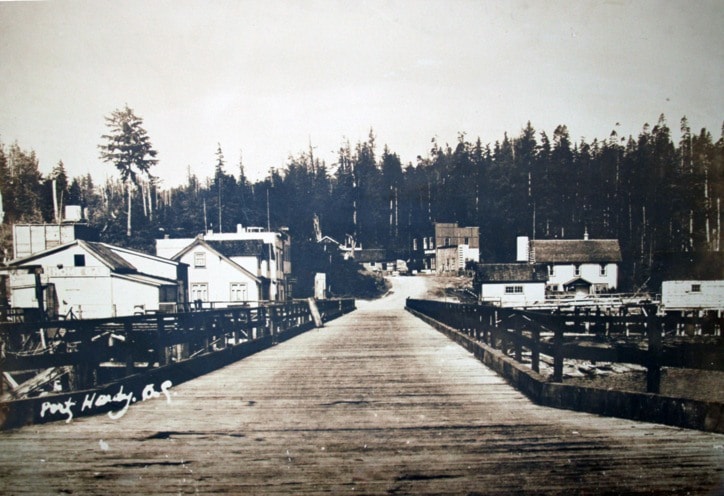Providing medical services in Canada's rural areas has evolved from the days of the country doctor general practitioner who handled all comers to the advent of satellite phones, air ambulances, and video tele-conferencing.
In this series the Gazette looks at the past, present, and future of medical services on the North Island. How are medical services provided in remote communities? What made nurses and doctors choose the North Island as their special place to practice medicine? What do practitioners think services will look like in the future?
This first installment reviews the history of health care on the North Island.
Alert Bay
Alert Bay was the first community on the North Island to establish medical services. The first facility, St. George's Hospital was built in 1908 and opened in 1909, but burned down in 1923. It was rebuilt in 1925. The hospital was administered by the Anglican Church until 1949, when the St. George's Hospital Society took over administration of the facility.
In 1949, when the original doctor moved on, Dr. Jack Pickup was hired. The new general practitioner soon realized that as the only doctor on the North Island he was needed not just in Alert Bay but also in more than 1,000 small camps spread over 10,000 square miles. The loggers, miners, fishermen, and First Nations were mostly engaged in inherently dangerous work. The doctor needed an expedient way to get reach patients in small communities on the inlets and lakes between Kelsey Bay, 100 kilometres south and Bella Bella 160 kilometres north. He chose to fly.
B.C.'s first flying doctor took a week off and earned his pilot's license in Vancouver in 1950. He purchased a float plane located in Kenora, Ontario and earned his float plane endorsement after two hours of instruction. It took a week for him to fly the Piper PA-12 Super Cruiser home to B.C. The same determination and courage that pushed the novice pilot through the daunting B.C. mountain ranges stood him in good stead for many years to come.
The doctor flew in all kinds of weather as situations demanded. He owned and used three different aircraft to transport himself and his patients over a span of 42 years until he retired in 1992 at the age of 73.
Port Hardy
Until 1950 most Canadians were treated by a country doctor or general practitioner (GP). In Port Hardy the first recorded medical practition was, Dr. Wilson, described as, "a man dedicated to his profession had provided services with his little black bag with no clinic to work out of," in A Dream Come True a book published by the Port Hardy Heritage Society.
"The GP attended home deliveries, pulled teeth, operated on kitchen tables, set broken limbs in fields, concocted mustard plasters over wood stoves, and ventured out at night to sit with the dying. Rural practice was a small business in which accounts receivable often exceeded accounts paid. Country doctors were rarely rich, but they lived well. ...rural medicine was as close to the orthodox European ideal as facilities allowed. If necessary, they performed autopsies to investigate murders." writes Jacalyn Duffin in Country Doctors .
Dr. Wilson donned his crash investigator hat at the crash of a Pacific Western DC-3 in June of 1957 where 14 people died and four survived.
"Besides their position at the rear of the plane," Dr. Wilson said in an article on Ancestry.com, "a contributing factor in their survival was that the rear door was sprung open by the crash impact,"
Dr. Wilson retired in 1962 leaving Port Hardy without a doctor. Having survived a winter without medical services and recognizing that no doctors were lining up to take Dr. Wilson's place, a women's auxiliary formed, and working in conjunction with the North Vancouver Island Medical Society, set up an emergency clinic in an airport building supplied by the Department of Transport. The two groups than subsidized the new doctors' salaries, providing a residence for the doctors, all the while fundraising and lobbying the provincial government for a hospital. In 1972 a ten-bed hospital was built in Port Hardy. The first nurses in Port Hardy's new hospital were Helen MacLennan, Gwen Saunders, and Monion Ferris.
Esperanza
In 1937 a hospital was established at Esperanza, near Zeballos, by the Shantymen's Christian Association. It was the only medical facility on the West Coast north of Port Alberni. Dr. McLean and his staff now stood between death and the simple infections, accidents, and treatable diseases that so often had lead to unnecessary deaths there.
The hospital was closed in 1974 and torn down in 1991. In its place, the McLean Centre was built in 2005 to provide a different kind of healing - counselling and care for families in crisis.
Kyuquot
In 2005, the Red Cross handed over responsibility for the operation of its first aide outpost at Kyuquot to the Vancouver Island Health Authority, VIHA. The first aide outpost, established in the late 1940s, serves the First Nations village of Houpsitas, inhabited by combined Kyuquot and Checleset First Nations peoples, and all others from its base in the tiny community of Kyuquot located on Walters Island.
The outpost was continuously staffed by nurses for more than fifty years.
"The transfer completes the Red Cross initiative to phase out outpost hospitals," said Shannon Marshall. At the time VIHA did not plan to make any changes to the operation.
"Nurses had to be prepared to deal with everything," said Bruce Andrews, spokesman for the B.C. coastal region of the Red Cross. "They did everything from removing fish hooks to bangs, bruises and broken bones. And they served the whole area. They have a boat and would head out to a house or locations where help was needed."
